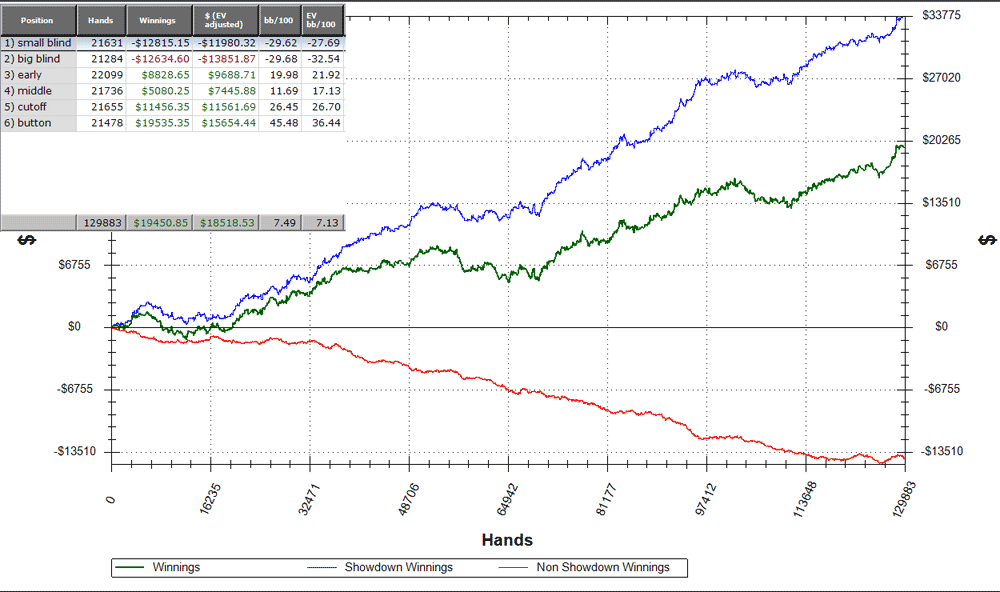Contents:
- How NOT to increase the red-line
-
10 situations where we can increase our red-line
How
NOT to increase the Red-Line

As discussed in part 1 of the series, many players manage to
achieve a positive/break-even red line through employing bad
strategies. Here is how they do it:
1. Calling too much.
Any losses through calling down too wide are not going to be
reflected in the red line, the blue-line will take a hit however.
2.
Bluffing with the best hand. Imagine a situation on the river
where we know a huge chunk of our opponents range is busted draws and
he loves to bluff. We are first to act OOP. If we bet, we will nearly
always take the pot down and win what's in the middle, increasing our
red-line. Assuming we check and let our opponent buff, we'll win
what's in the middle plus an additional bet. In the second scenario
the profits will be represented in our blue-line. We'd rather take
the increase to our blue-line in this case since it results in a
larger increase to our overall green-line.
3. Bluffing in
bad spots. Bluffing in spots where our opponents range is very
strong or simply trying to bluff opponents who rarely fold. We will
lose money overall trying to do this, but since we are not folding
ourselves, the losses are going to be represented in the blue-line.
If we'd correctly check/folded our losses would have been represented
in the red line, which is preferable since the losses will be
significantly smaller in this case.
Each of these three pointers is a negative trait. In order to
improve overall winrate it is necessary to first remove each of these
problems from our game. The initial impact of such an adjustment is
that our red-line will become worse than it was before. The
improvement in our blue line should more than compensate however –
this will then leave us free to improve our red-line using correct
strategies.
How to Increase the
Red-Line
One thing to keep in mind is that each of these situations can be double-edged. For example we might drastically increase our stealing frequency but then start to lose money in situations where we are getting 3bet. It's not always so black-and-white as “do X and then your red line will increase”, but here are some of the factors that can have a significant affect on red-line when used correctly.
Stealing – Many players are not defending as often as they should be vs raises in late-position and we can capitalise on this by opening wider than is theoretically optimal. The catch is, not to spew postflop when we open-raise 82o and get called, since this can totally negate any additional profits we make with our aggressive steals.
3Betting – This is similar to stealing. There is a
pretty reasonable correlation between how often someone 3bets and how
high their red-line is. The wider we 3bet the more postflop skill is
required – so there is a limit. We don't want to increase our
red-line and end up donating a ton of money with our blue-line.
Preflop aggression when used correctly is a great way to increase
red-line earnings.
Cbetting – Many players are not defending as much as they should vs cbets which we can exploit. A cbet of 2/3rds pot needs to work around 40% of the time in order to show an instant profit. If players are folding too much to cbets we can exploit this by cbetting wider than is theoreticaly optimal. We should use this in conjunction with other strategies. For example 3betting wide in itself may not do that much for our red line, but follow it up with the appropriate amount of cbets and doube/triple barrels then we really start to print red-line dollars.
Blinds defence – It doesn't take a lot of work with
tracking software to determine that the vast majority of our red-line
losses come from the blinds. The way we counter-act this is to defend
more frequently. For many years it was considered correct to defend
tight from the blinds. The best players now understand that is
necessary to defend aggressively from these positions at the table.
Doing so correct can have a huge impact on red-line.
Flop
check-raise – This specifically should be used in conjunction
with defending the blinds more aggressively. It would be a mistake
simply to call more hands in the blinds and then play a passive
fit-or-fold strategy. Since we now have a wider range to defend in
the blinds it's necessary to check-raise the flop very aggressively
especially in late position battles where the range of the opener is
also wide.
Floating – Another trick that can be used
after defending the blinds aggressively. This will usually be used on
dry textures whereas we can tend towards x/r the drawy textures.
After we call the flop it's generally with the intention of donking
turn or going for a delayed bet on the river.

2 or 3 barreling – This is especially effective when we can identify that our opponent's range is capped. For example we x/r them in a spot where we expect them to 3bet their sets nearly always because the texture is drawy. On blank runouts we can play very aggressively since we know they likely just have weak-pairs and draws.
Orphan pots – Those pots that just get checked down and no-one really seems that interested. Making small bets on the river and picking this up will increase our red-line in the long-term.
Multi-way Aggression – Players have a tendency to play very straight-fowardly in multi-way pots. For this reason they can be excellent pots to bluff at. We also represent a stronger range when betting multi-way. One aspect missing from many players game is mixing in multi-way donk-bets. Leading at multi-way pots is very frequently more effective than hoping the original raiser decides to cbet.
Playing vs missed cbet IP/OOP – One of the most profitable situations when cold-calling preflop IP is when the original raiser checks and we are in position. Many players do not defend frequently enough when they check as the pre-flop-raiser. We can exploit this by betting frequently and making auto-profit.
One of the most profitable situations when defending from the blinds OOP vs an open is when the raiser checks back rather than cbet. Good players can define opponents range clearly in these situations and know whether2barreling, betting-once, or overbetting is the strongest option. Overbets are completely missing from most players games in this situation and can be a great source of red-line profit.


